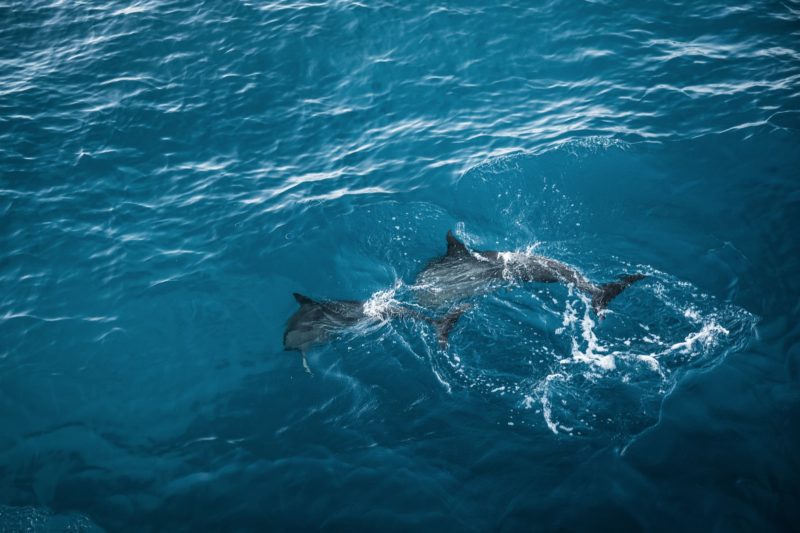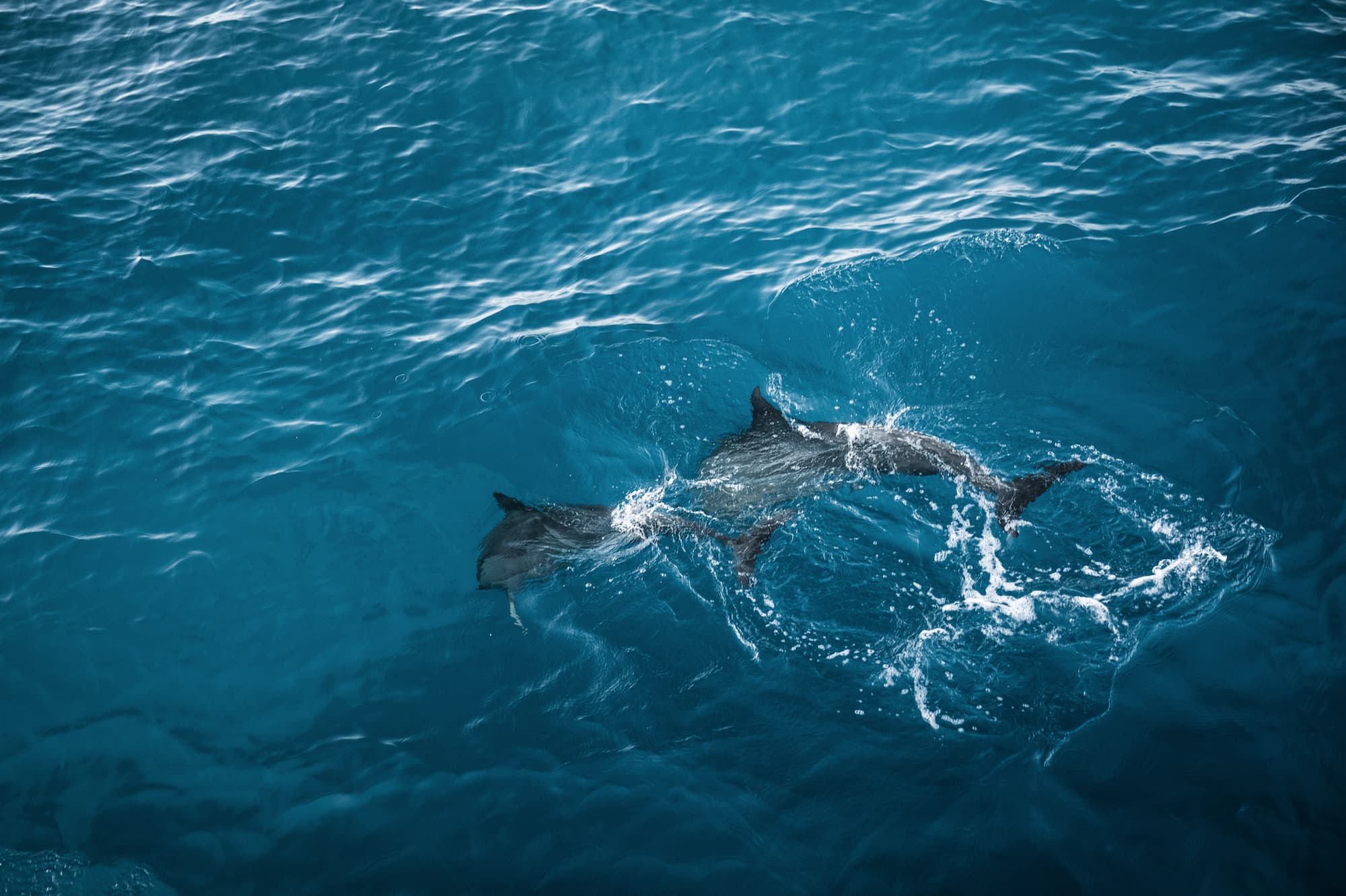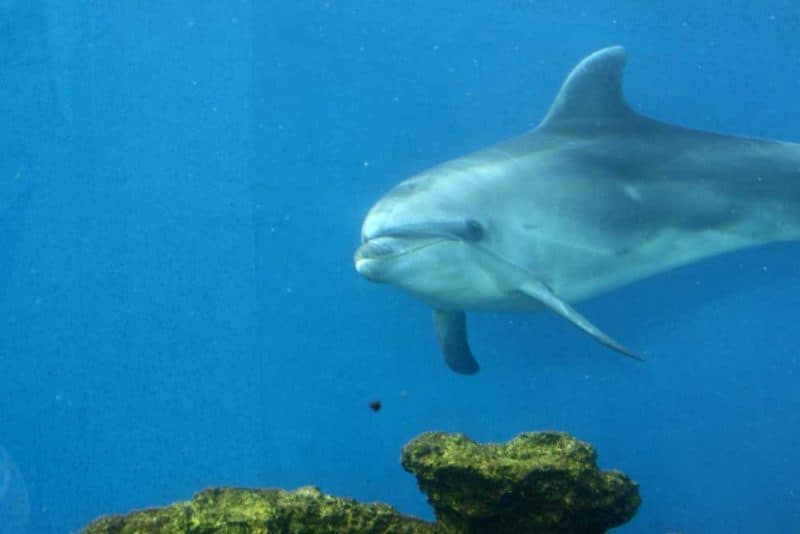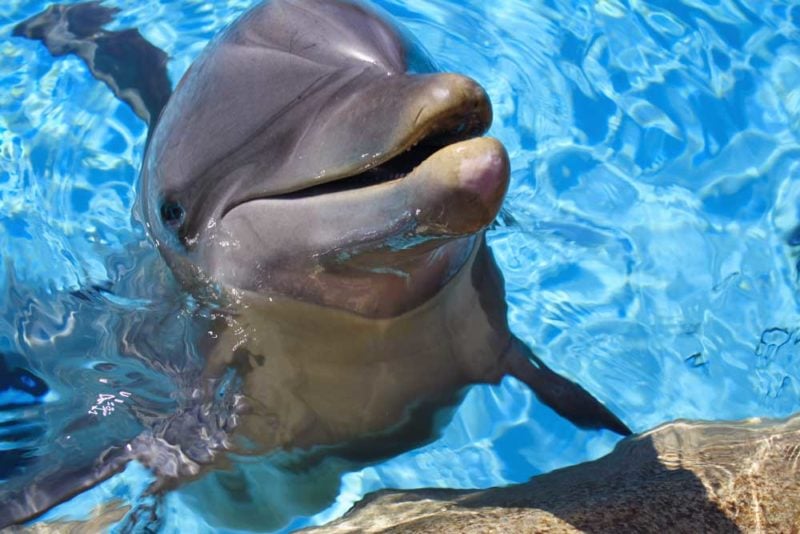Swimming with dolphins is often described as an unforgettable experience that will leave you with memories for a lifetime. This guide gives a short background on dolphins, explains how to behave around wild dolphins, and list two options for responsible “swim with dolphin” tours:
Table of contents
- Swimming with dolphins FAQ
- About Hawaiian dolphins (introduction)
- where to see dolphins
- How to behave around wild dolphins (+ boat guidelines)
- Responsible swim with dolphin tours:
- Snorkeling tours
- Visit/swim with captive dolphins
Table of Contents
- Swimming with dolphins FAQ
- About Hawaiian dolphins (introduction)
- where to see dolphins
- How to behave around wild dolphins (+ boat guidelines)
- Responsible swim with dolphin tours:
- Snorkeling tours
- Visit/swim with captive dolphins
Swim with dolphin tours vs. dolphin well-being
Here on the Big Island swimming with dolphins can be done by people of all ages and swimming skills BUT there is one important “however” to consider when researching this activity: the well-being of the dolphins.
Why?
‘Swim with dolphins’ tours can be harmful to the dolphins themselves and at the moment we don’t recommend any of these tours. If you are lucky you can experience swimming with dolphins when a curious wild dolphin approaches you to check you out. If the dolphin swim is a real ‘bucket list’ activity for for you, you could consider swimming with captive dolphins.
Frequently asked questions about swimming with dolphins
In the following dolphin FAQ we tackle some of the most frequently asked questions about dolphin swims. Please get in touch with us if you have any other question about this topic that is not answered in our guide.
There are two different ways of seeing dolphins as part of a tour when visiting Hawaii. Neither of these options is perfect from the animal perspective but they are an acceptable compromise when balancing the great demand for dolphin experiences with animal welfare. These two options are:
- Go on a snorkeling tour to a place where dolphin sightings are (almost) guaranteed
- See (and swim with) captive dolphins
The National Oceanic and Atmospheric Administration rule under the Marine Mammal Protection Act prohibits swimming with or getting within 50 yards of a wild spinner dolphin, so if you want to get very close to a dolphin on Hawaiʻi your only legal option is to see (and swim with) captive dolphins.
We think the best way to see dolphins while on Hawaiʻi is to take a snorkeling tour to a place where dolphin sightings are (almost) guaranteed – for example to Kealakekua Bay.
Many dolphin tour providers offer dolphin swim tours where they track dolphins with their boat to put people in the water in front of the moving pod. According to NOAA rules this is prohibited, and tour operators offering such tours should be avoided.
Dolphins in Hawaii
“Naiʻa” is the Hawaiian name for dolphins. It refers to any species of dolphins found in the Hawaiian waters, which can mean one of the following four: [1] The pacific bottlenose dolphin. [2] The rough-toothed dolphin. [3] The spotted dolphin. [4] The spinner dolphin.
Of these four, spinner dolphins are the smallest and most commonly seen dolphins in Hawaiʻi. The pacific bottlenose dolphins are known for their playfulness and star appearances in aquariums worldwide.
What is the best place on the Big Island to see dolphins?
Spinner dolphins in Hawaiʻi rest during daylight hours in the shallow and sandy-bottom bays along the Kona Coast of the Big Island. These bays provide protection from predators found in deeper waters yet still are close to the more off-shore feeding grounds where the dolphins forage overnight.
The best places to spot wild dolphins are at the Kona and Kohala coasts. The weather on this side of the island is good year-round so don’t forget to pack sunscreen. You can sometimes even see dolphins play from Aliʻi drive in downtown Kona, in the bay.
How to be on your best behavior around wild dolphins
Dolphins are very smart and playful mammals and it can seem like great fun for both parties to play with dolphins. However, seeking out and trying to interact with the dolphins disturbs their natural behaviors and can interrupt much-needed rest periods.
Interactions between wild animals (dolphins) and humans are almost always disadvantageous for the animals but there are ways to mitigate the impact. The most important thing you can do is respecting the resting behaviors of the spinner dolphins.
Spinner dolphins, the dolphins most commonly targeted by swimming with dolphin activities here on the Big Island, seek out sheltered bays with sandy bottoms in order to rest. These rest periods are crucial to their well-being. Unfortunately, tours that promise dolphin swims often go to these bays to find the dolphins during the resting periods.
Spinner dolphins are creatures of habit and have four well-known resting grounds where they socialize and rest during the day. These bays are:
- Makako Bay north of Kona, next to the Kona International Airport
- Kealakekua Bay south of Kona, one of the best snorkeling spots on the island)
- Honaunau Bay. Another great snorkeling spot, next to the very interesting Puʻuhonua o Honaunau National Park.
- Kauhako Bay 23 miles south of Kona, just above the Hoʻokena beach park and camp site.
Especially in these bays you should take care not to disturb dolphins during daylight hours, particularly so during their peak resting period between 6:00 AM and 3:00 PM.
You can read more about efforts to reduce the tourist impact on Hawaii’s spinner dolphins on the very interesting blog Raising Islands, and in this study on the importance of spinner dolphin resting habitats, which is discussed here in depth.

Spinner dolphins swimming off the Kona coast. Credit: Island of Hawaii Visitors Bureau (IHVB) / Julie Hotz
Guidelines for seeing dolphins with a boat
If you have your own boat and happen to see dolphins, please observe the following guidelines:
- Remain at least 50 yards (1/2 a football field) from spinner dolphins.
- Limit your time observing to 1/2 hour.
- Spinner dolphins should not be encircled or trapped between boats or shore.
- If approached by a spinner dolphin while boating, put the engine in neutral and allow the animal to pass. Boat movement should be from the rear of the animal.
You can find more information at the NOAA “protect dolphins campaign”. Please stay safe and treat the dolphins with aloha – observe them from a distance.
There are a couple of things you can do to book the most dolphin-friendly tour:
Swim with dolphins tours
There are two different ways of seeing dolphins as part of a tour when visiting Hawaii. Neither of these options is perfect from the animal perspective but they are an acceptable compromise when balancing the great demand for dolphin experiences with animal welfare. These two options are:
- Go on a snorkeling tour to a place where dolphin sightings are (almost) guaranteed
- See (and swim with) captive dolphins
- Tours you shouldn’t participate in
1: Dolphin snorkeling tours
You might bump into dolphins while enjoying one of the many ocean activities on the Kona (Western) coast all by yourself, but if you want to seriously increase the chance of that happening you should consider booking a dolphin snorkeling tour. These tours frequent know resting grounds of dolphins which almost guarantees sightings.
Such tours include fantastic snorkeling, last about 4 hours, and set you back around $150/person. Snacks, water, and snorkeling equipment are generally provided to the guests aboard, but be sure to inquire about this when you book a tour.
Body Glove Hawaii offers a morning snorkel cruise which offers an excellent chance of dolphin and other marine mammal sightings while they cruise to the snorkel site (note: there is no dolphin guarantee). Body Glove adheres to NOAA dolphin viewing guidelines and doesn’t let people in the water with the dolphins. Dolphins often come very close to the catamaran they use for tours though as they play in the waves behind the boat.
Deluxe Snorkel & Dolphin Watch
Step aboard a 65’ Catamaran for a fun-filled day of adventure! This 4.5 hour cruise offers breakfast, lunch, and all the comforts you would expect from being on a $2 million vessel.
from:
$175
What is a suggested tour?Our suggested tours are hand-picked tours that receive consistent good reviews, give back to the community, and work hard to minimize their impact on the environment. Read more about these tours on our website.2: Captive dolphin tours
As an alternative to dolphin encounters in the open ocean you can consider the Dolphin Quest at the Hilton Waikoloa village. Dolphin Quest ’employs’ captive (resident) dolphins and is certified Humane by American Humane and accredited by the Alliance of Marine Mammal Parks and Aquariums. This way you still get to be in the water close to real dolphins without causing unnecessary harm.
3: Tours you shouldn’t participate in
Some operators offer dolphin tours where they track dolphins with their boat to put people in the water in front of the moving pod. Following and chasing a pod of dolphins is stressful and can disrupt the natural feeding/sleeping cycle of these animals. Please refrain from supporting these kind of practices and choose a more sustainable way of seeing dolphins. Mahalo!


